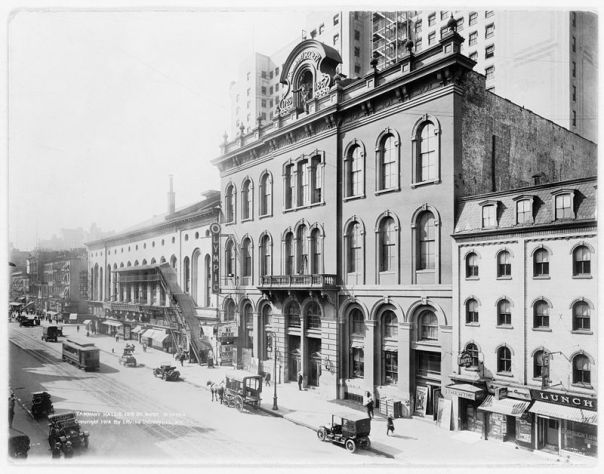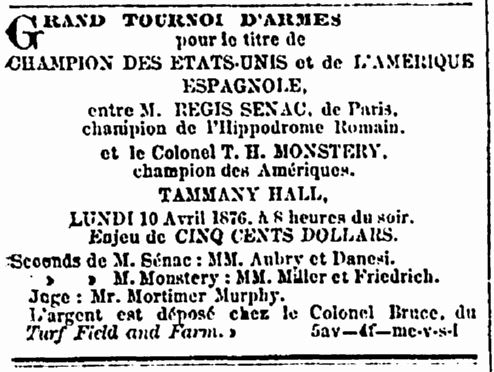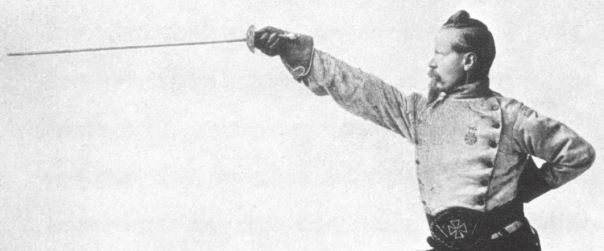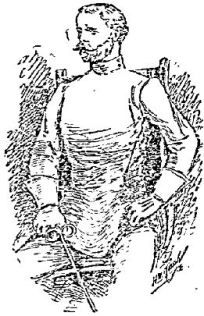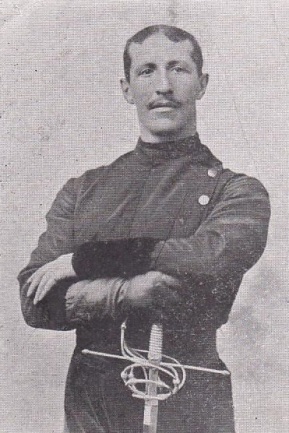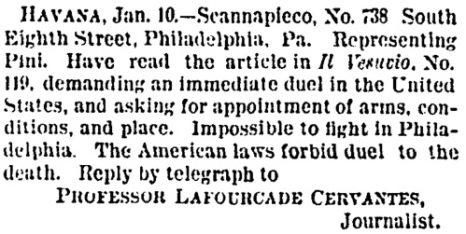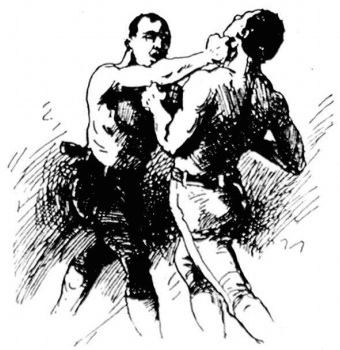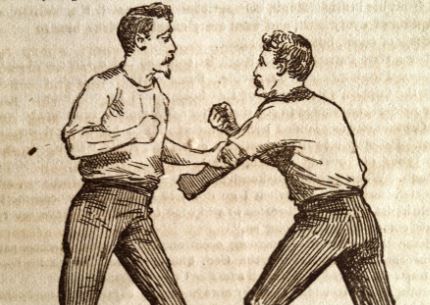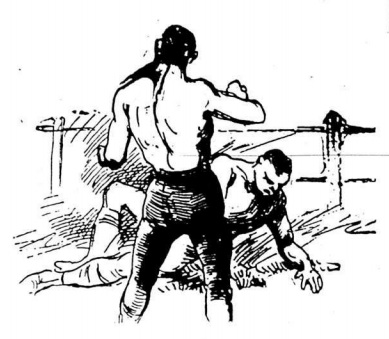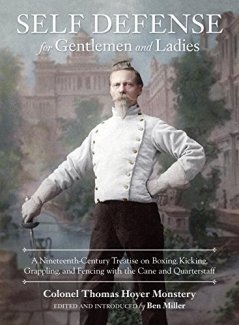In April of 1876, New York City played host to one of the most public and controversial American fencing contests of the nineteenth century. The disagreements over judging decisions and methods of scoring were so great that “inflamed” arguments erupted between the referee and the combatants’ seconds. At times, angry audience members rushed the stage and had to be removed from the premises by police. Before the day was over, one of the combatants walked off the stage in the middle of the contest, and the entire event broke up in disorder. Eventually, the two contestants would come to personal blows. In the weeks following, conflicting accounts of the contest appeared in various New York City newspapers, and witnesses from the day published impassioned letters about what they saw, attempting to set the record straight.
Now, even more than 130 years later, it is not exactly clear what transpired at this event. The dispute over the contest, however, highlights issues that are relevant today—just as they were then—for practitioners of traditional, classical, and historical fencing, as well as other martial arts.
“CHALLENGE TO SWORDSMEN”
The event had arisen from a “Challenge to Swordsmen” issued one month prior by Colonel Thomas Hoyer Monstery, a veteran duelist and noted New York City fencing master. Writing in the New York Herald on March 7, 1876, Monstery proposed a “tournament at arms” for the championship of the United States and Spanish America, and a purse of $500 dollars, on the following conditions:
“That the money and title of championship belong to him who makes the first fifty-one points, with the weapons mentioned, the points to be distributed as follows: —
- Foil ……………………………. 12 points
- Sabre ………………………….. 9 points
- Rapier (cut and thrust) …. 12 points
- Bayonet (thrust) …………… 9 points
- Knife (cut and thrust) ……. 9 points
Each principal to employ two seconds; the referee to be a mutual selection.”
If Monstery had intended for the contest to take on national (or international) proportions, he was at least partly successful. The challenge was picked up and reprinted in newspapers across the country, from New York to Chicago to Louisiana. The New Orleans Times, on March 13, announced:
One week after Monstery’s initial announcement, on March 14, the challenge was accepted by Maitre d’Armes Regis Senac. A native of France, Senac had arrived in New York City in 1872, and had set up a fencing school on University Place in Manhattan’s Greenwich Village. The Frenchman had reportedly fought three duels in France and had emerged victorious from all. Monstery, on the other hand, was a far more experienced duelist, having taken part in, according to various accounts, somewhere between fifty-two and sixty-one personal combats; he had also fought under twelve flags on three separate continents in numerous revolutions and battles. Both men were former soldiers who had been educated in the military academies of their respective countries—Senac at Joinville-le-Pont in France, Monstery at the Royal Military Institute of Copenhagen, Denmark.
The following rules are extracted from the “Articles of Agreement” entered into by Monstery and Senac, and published in the March 24th issue of Turf, Field, and Farm:
- The foil to be 34 inches long, have a flat blade and be unattached to the hand or wrist by cord or string to prevent being disarmed.
- A free thrust must be followed by a pause, if the thrust has been successful.
- No cuts from the sides or from above to count, nor those delivered on the neck, mask, arm, hip or leg.
- After each attack the fencer to return on guard, or give proper time for his opponent to return before he makes another thrust, therefore, reprisals or double thrusts are not allowed.
- Time or stopping thrusts delivered without the lunge, count only in favor of the giver if not hit himself; if both are hit, the count belongs to the party who lunges. If both are hit simultaneously while making the lunge, it is of no count.
- A disarm to count one point, but if the foil is lost while making the attack and hitting the opponent it counts one point.
- It is forbidden to parry with or take your opponent’s foil with the left hand.
- If one of the opponents retires before the end of a play, he loses this play.
- No cuirass allowed under the vest while fencing with the foils.

Regis Senac. Source: https://www.pinterest.com/pin/454863631089389789/
Regarding the other weapons, it was merely noted that with the sabre, “cuts with the edge of the blade upon any protected part of the body above the hips to count”; with the rapier, “all cuts and thrusts above the hip to count; no cuts with the flat of the blade allowed”; with the bayonet, “thrusts only count, and these when delivered straight on the cuirass protecting the trunk of the body”; and with the knife, “cuts and thrusts to count when delivered on the cuirass and right arm.”
The articles of agreement concluded with signatures from both combatants, as well as those of their seconds: for Monstery, Louis Friedrich of the New York Turnverein and Prof. William Miller of Australia; for Senac, A. Aubry and Danesi.
Notably, the articles contained no mention of a judge or referee having been selected, and it is not certain how–or at what point in time–John Mortimer Murphy, an Irishman, was chosen for the position. Murphy’s greatest accomplishments seem to have been his writings on “sporting matters” and Western fauna; there is, however, no evidence that he had any prior experience in fencing—either as judge or practitioner. It is safe to assume that both Senac and Monstery must have agreed on the choice of Murphy; as to why remains a mystery. In an interview given several years later, Monstery hinted that a desire for impartiality may have taken precedence over a need for competency:
“Where shall we get competent judges excepting among Frenchmen who are unbiased by acquaintance with either of us, and who would serve upon such an occasion? Seven out of eight men who understand fencing [in New York City] are Frenchmen, and with them it is an article of faith that nobody but a Frenchman can fence, just as Englishmen imagine that nobody but an Englishman can really box.” (New York Sun, Jan. 6, 1880)
Throughout his career, Monstery often espoused an anti-French sentiment, and in that light this comment may come as little surprise. Yet Monstery was correct in his assessment of the number of New York-based fencing experts; during the 1870s, the only notable masters that we have been able to find mention of in the local press, besides Senac and Monstery, were Jean De Turck, Captain Juillard of Woods’ Gymnasium, Hyppolite Nicolas, and Louis Friedrich of the New York Turnverein. All were French except for Friedrich, and the latter, who served as Monstery’s second in the Tammany contest, and had also held joint fencing events with the Colonel, was likely considered too biased to serve as a judge. Monstery was also correct in that nationalism was often a strong influence in fencing contests of the period, especially when they involved French or Italian contestants.
As April came around, the publicity and anticipation for the event continued to mount. The date of the event, it was announced, was to be April 10th, and the setting, Tammany Hall, as noted by the Herald:
Notice of the contest even made the French-language Courrier des Etats Unis, which announced on April 5th:
THE TOURNAMENT – April 10th, 1876
The day of the contest finally arrived. It was noted by one reporter that “both contestants were attired in fencing uniforms, and Senac wore the gold medal of Grisier’s Academy of Arms, in Paris.” Interestingly, a biography of Monstery published during the same period noted that during a visit to Paris in the 1840s, Monstery had beaten and twice disarmed the fencing master Augustin Grisier in a public assault; one wonders if this fact somehow contributed to an increased sense of rivalry between himself and Senac. As to the fencing contest itself, to relay a simple, straightforward account of the event would be impossible, as shall be seen.
The morning after the contest, on April 11th, the New York Herald published its own report:
“The contestants fenced with foils, sabre and rapier, and in the use of each weapon Senac manifestly excelled. The referee, John Mortimer Murphy, erred several times by awarding points to Monstery that belonged to Senac. In the rapier fencing when Senac had scored 6 points and Monstery 5, the latter retired from the stage, evidently having enough of it. The lights near the platform were then put out, and the crowd gathered around it and demanded the referee’s decision. It was a long time before he could be got to speak. He declared at last that, as the match was “play or pay,” and Monstery’s physicians had advised him not to renew the contest, Senac was the winner.”
In another brief account, published on the same day, the New York Times concurred that Senac was the superior fencer, that he “had the advantage over his antagonist both in agility and skill,” and that “his attack was quicker and better sustained.” The Times also agreed that the referee had been unfairly partial to Monstery—despite the fact that Monstery had been officially declared the loser in two out of the three bouts.
A few details in the Times’ account also pointed to the chaos and confusion of the day. The audience had proved an unruly one; according to the Times, “among the other incidents a young Frenchman…on behalf of Senac, protested against a decision of the referee, [and] was, at the request of that personage, removed from the stage by Capt. Garland, who with a strong force of Police was present.” The Times went on to note that during the rapier contest, “there was nothing but argument and quarreling between the seconds and the referee.” It also noted that the referee, John Mortimer Murphy, “proved wholly incompetent to perform the important duties allied to such a position.”
Both reports in the Herald and the Times paint a decidedly unflattering portrait of Monstery—one of a man who had been soundly and definitively defeated by a superior swordsman; one who, unable to accept the outcome, used the cover of sickness as an excuse to end an otherwise fairly conducted contest.
In the coming days, however, that version of events would be called into question by a number of other accounts published in the New York City press.
On April 14, the following article appeared in Turf, Field, and Farm:
“The tournament of arms at Tammany Hall, on Monday night, which was to decide the sword championship of the United States and Spanish America, decided nothing. True, the money was awarded to Senac, but it was not proved to the satisfaction of all that the lithe and active Frenchman was the most scientific and expert in the use of weapons of steel…Instead of deciding disputed questions, [the referee] argued with the inflamed seconds and appealed to the audience. Senac never failed to claim a hit, and his seconds were ever prompt to support his claim. As the wing Frenchman was the favorite in betting circles, the shouts were loudest for him in the audience. The referee perspired, shrugged his shoulders, and looked the picture of irresolution…It was the opinion of keen-eyed judges in the audience who had no money on the match that Monstery did not receive credit for all the points he made…If another match is made between these two famous swordsmen, it is to be hoped that a referee will be selected who can tell what a palpable hit is when he sees it, who will listen to, but not argue with, the seconds, and who will have nerve enough not to be overawed by the partisan sentiment of the house.”
The author’s name did not accompany the article, although it is safe to assume that they were either a staff writer or contributor for Turf, Field, and Farm. In the end, it is difficult to know whether the writer was a friend or partisan of Monstery’s, or merely an impartial observer with a well-trained eye.
The next day, on April 15, a lengthy journalistic account of the contest was published in the United States Army and Navy Journal. This report proved to be the most detailed of any, and evinced the same sentiment as the account in Turf, Field, and Farm:
“At about half-past eight the two fencers made their appearance with their seconds and the referee. It was at once announced that the number of points were to be reduced to thirty-nine, in favor of Colonel Monstery, who had but just recovered from severe sickness. The appearance of the two champions was very different, and the disparity in age was, we are informed, nearly twenty years… Monstery is now a tall, gaunt, wiry man, with a manner of great dignity and repose, reminding one very strongly of the gallant old knight of La Mancha in his personal apparance. Senac is shorter and stouter built, with a dark but handsome face, small hands and feet, and a peculiar catlike grace and activity that reminds the beholder of a tiger. The contrast could therefore hardly be greater than between the two. It was quickly evident in the foil contest that the elder man was past his prime, or else had not recovered from his sickness. It was also evident that as far as the science of defence went he was superior to the Frenchman, while the latter, from his youth, strength, and quickness had the advantage in the attack. Senac was at first too eager and rash. He made two fierce attacks, and was twice disarmed, the elder man keeping cool and forcing the sword out of his hand as he thrust in octave. It was very difficult at the beginning of the match to see what was going on, as the seconds of Senac would insist on getting in front and hiding their man. Monstery’s seconds were much better and cooler. One of them was the great Graeco-Roman wrestler [William] Miller, himself a fine fencer.
The referee turned out to be ludicrously incompetent for his position, as became visible when the contest waxed warm. After Monstery had gained four points, Senac suddenly changed his tactics, and this time completely puzzled his antagonist. He abandoned the defence entirely, did not attempt to parry a single thrust, but trusted entirely to what is known as the “coup d’arret” in French, “stop thrust” or “time thrust” in English…Of this thrust Senac is a master, and by its use he quickly counted nine points. Some of them were very fine ones, as when he actually bent his foil into a curve before an assault, so as to get in a point on Monstery‘s arm, which he could not have done with a straight foil. His last point was the perfection of the “stop thrust.” He sprung back to the end of the stage and crouched almost on one knee. Monstery rushed in; and like a flash the Frenchman was up, and the foil bent into a semicircle on his enemy‘s breast, while Monstery‘s point was past him. The score then stood: Senac, 9; Monstery, 4; and the champions rested for fifteen minutes.
The sabre followed. Here the tables were turned. The old champion looked to better advantage in his white armor suit, and proved the French professor’s master. In this play Senac tried the same tactics which had proved so successful with the foils, but with very different results. Cuts above the hips were only allowed to count, and of these he hardly got in a single one, while Monstery struck him fairly again and again. He then tried a very peculiar game. Thrusting (prohibited), he would pass Monstery’s body, receive a cut on the helmet, and laying his own edge on Monstery’s shoulder would claim it as “a cut.” It was here that the referee showed his incompetency. Not one of these was a fair cut, and during the whole bout Senac never parried once, but trusted that this sort of sawing motion would be called a cut. The referee allowed it on several occasions, till the score stood—Monstery, 6; Senac, 5, when it should have been, Monstery, 11; Senac, 1 (this was at the beginning, a fair cut). To make matters worse the referee actually appealed to the audience on disputed points, and every passage of arms was followed by a wrangle of all the seconds for several minutes. Finally Monstery was declared victor with the sabre, 6 to 5.
At last came the rapier…Again Senac tried the same old tactics, but the straight sword and bent foil were different things. He received several severe cuts on the head and body and one on the arm, but each time cut or thrust back at the same moment, and always claimed the point. Also he began to cut savagely at Monstery’s leg, which was only lightly protected, regardless of the fact that under the rule the point did not count. The referee kept giving his decisions at random, first to one and then the other, while the audience began to shout and roar at each new count, which seemed to be decided on the principle of chance. At last, when the count stood five to five, on the deciding bout, both claimed the count as usual. Monstery had given a fair cut in carte on the left shoulder of the other, and Senac claimed a similar one, which really fell below the belt or too late, it was impossible to tell which. Monstery then said that as the referee would not give him points he had earned, he would continue the contest no longer, and very unwisely retired from the stage, while the whole affair broke up in disorder. Senac was subsequently declared the victor.
Taken as a whole, we were much disappointed with the management of the affair. The feeling between the champions was evidently very intense, and Senac especially fought very wickedly. At the same time it is doubtful whether Monstery will ever again be a match for a young athlete like Senac. The chief lesson to be learned of the victor is that of the use of the “stop thrust” of which he is a master. In the sabre contest, he would have been ruled off the stage in England, Germany, or France over and over again, and with sharp swords Monstery would even now probably prove the best man.”
But that was not the end of it. Six days later, on April 21, a letter sympathetic to Monstery appeared in Turf, Field, and Farm. This time, the author (writing under the nom de guerre, “Swordsman”) criticized the fencing strategies and techniques used by Senac and the manner in which such techniques were scored:
“It may seem rather late in the day to say anything concerning the fencing match that came off on the 10th of this month, between Prof. Senac and Col. Monstery; but as a lover of fair play, I think that something ought to be said for the benefit of your readers who are not themselves swordsmen. I take the liberty of sending this to you, because your paper (with one exception) is the only one whose reporter seemed to know anything about the use of the sword.
In the foil assault, which came first, Monstery quickly got in the first two hits. In the third attack, he disarmed Senac (as he did twice subsequently) and soon got in another hit. After this fencing ceased. Senac–either because he could not, or for some other reason–never attempted to parry a thrust, but lunged when Monstery did, or made use of the “time thrust.”
Now, let me say a word about the “time thrust.” In the first place, one of the rules said: “The ‘time thrust’ shall count in favor of the giver only when not hit himself, and if both are hit, the count shall be given to the party who made the attack.”
Now, if this rule had been followed, Monstery would have soon run his score up to the required nine, because in only one or two of the “time thrusts” did Senac escape a hit. The design of rules in fencing is to make the assault as much like a mortal combat as possible, and only thus far of they of use. Now, who would think of making use of the “time thrust” in a duel? For he would be simply taking a thrust through his bowels for the sake of scratching his opponent’s shoulder, or at most wounding him in the neck. In a duel, when one makes an attack, the other will parry it if he can. In fact, when a person begins to make use of the “time thrust,” he virtually acknowledges that he is not able to parry; and in Europe, if a man persisted in using it, he would be hissed off the stage.
In the assault with the sabre, Senac scored the first point by a clever cut on his opponent’s head; and this was the only point in this assault that really belonged to him, for he then fell back on his old tactics of refusing to parry, and when Monstery would cut, Senac would thrust past him, and laying his sword upon Monstery’s shoulder would commence a sawing motion which he claimed as a cut. The rapier contest was but a repetition of that with the sabre. In the sabre contest, as a paper of this city has truly said, “Senac would be ruled off the stage in England, Germany or France over and over again.” We cannot understand how so noted a swordsman as Prof. Senac could consent himself to use such a means to win a match as he did in this.”
In scrutinizing some of the points made in this letter, it is immediately clear that it could not have been written by Monstery himself, nor by any of his serious disciples. Monstery was never averse to the use of the time-thrust—in actual duels, or in contests with blunt weapons. In an 1863 duel “a la morte”, Monstery had defeated an expert fencer named Victor La Lieux by using the time-thrust. In the rules for his contest with Senac, Monstery had made provisions for scoring proper time-thrusts. And in his own writings, Monstery praised the “legitimate” time-thrust and stop-thrust, which, he asserted “are marks of the highest skill in fencing if the giver not be hit while delivering them.”
So what phenomenon, exactly, was the author of the last letter attempting to describe?
Following is a description of the time-thrust from Fencing (1890) by Camille Prevost, Maitre d’Armes:
“The time-thrust is an attack made with opposition on a complicated attack, and intended to intercept the line where such an attack is meant to finish. The time-thrust is a thing of the most accurate judgment and readiness; you must, to execute it, gauge both the attack and the quickness of your adversary. Well done, it is one of the best things, ill done, one of the worst things, in the possibilities of fencing.”
During the nineteenth century, many fencing masters warned of the dangers resulting from improperly executed time-thrusts (i.e., incurring simultaneous hits). For instance, Joseph Roland, in 1809, stated,
“Observe, that no time thrust is good if you are hit at the same time, and to avoid which you should generally take the time when the adversary thrusts over the arm, observing to oppose your blade to that side an which he might have hit you with his thrust, and by this opposition his foil will necessarily pass by the side of your body.”
Or, as T. Griffiths stated in The Modern Fencer (1868),
“Never take the Time Thrust unless you are pretty certain that you will not get hit at the same time.”
The present question then remains: during the 1876 Tammany contest, was Senac utilizing the legitimate time-thrust, or was he merely attacking into Monstery’s attacks, and incurring double hits, which were then mostly scored in his favor? If he was attempting to utilize genuine stop-thrusts, was he failing to execute them properly (incurring double-hits), and then getting rewarded for them?
One might look to the fencers themselves for answers. Several years after the contest, in a letter to the New York Sun, Senac recounted:
“The match…was not satisfactorily ended owing to my adversary’s willful retreat. The referee decided that I was entitled to the title of champion of America and his decision was ratified, I am proud to say, by the unanimous applause of the public. That title has been honestly won and I can add, honorably borne by me ever since.” (New York Sun, Jan. 5, 1880)
In separate interviews given in the next day’s issue of the Sun, both men related their accounts and feelings about the day. Senac stated,
“There [in Tammany Hall], as the reports show, I defeated [Monstery] easily, and he became enraged and went away before the match was ended. Instead of saluting when I touched him, as he should have done, he contented himself with abusing me.”
Monstery was quoted in the same article as saying:
“I struck him five times out of six, and every time they marked a score to him. At last I lost my temper at such apparent cheating, threw down my weapon, and came away.”
Unfortunately, either Monstery neglected to elaborate on what such “cheating” consisted of—or the Sun neglected to print it. Such accounts by the men themselves shed little light on what actually occurred.
THE FIGHT AT SCHILLING’S SALOON
The bitterness between Monstery and Senac continued to endure. Their feud finally came to a head on New Year’s Eve, 1879, when Senac entered Schilling’s Saloon on Sixth Avenue, and encountered Monstery at the bar. Senac reportedly greeted Monstery in French, then followed it with an epithet, also in French. Rather than replying to Senac directly, Monstery turned to Schilling, and remarked, “What’s that he says?” Senac reportedly interpreted this as an insult, and a hostile back-and-forth between the two men ensued, involving, among several things, “charges of unfairness in exhibition matches”:
“At length Senac gave Monstery a push in the chest. A left-hander in the cheek from the latter bowled his adversary over. Senac hastily arose and clinched, and Monstery went over in his turn. On rising he got a rap on Senac’s chin, which sent him staggering. Then they wrestled. Both men were skilled and very powerful, but were illy matched in age. Monstery is a sturdy veteran of 59, though he looks younger, and Senac is under 40. Monstery seized him by the seat of the trousers and lifted him. Senac caught Monstery by a leg, sent him over, and rolled on him. Both regained their feet and took their coats off for a climactic set-to, when a policeman who had been called entered and spoiled the match.”
The two then went home, “only slightly damaged.” A few days later, on January 5, 1880, the account of their brawl appeared in the pages of the New York Sun, under the headline: “SWORDSMEN USING THEIR FISTS. Monstery and Senac, the Fencing Masters, have a Quarrel and a Fight.”
OTHER INCIDENTS, AND EVIDENCE
A final question remains, which may indeed give us some insight into what happened in Tammany Hall in April of 1876. Namely: are there any other precedents for similar incidents in Monstery’s or Senac’s careers?
In Monstery’s case, the answer is a resounding “no.”
Throughout the second half of the nineteenth century, Monstery faced a variety of opponents in numerous public contests, and won virtually all of them. Two, however, he did lose—both during the twilight of his life. In November of 1893, Monstery faced Eugenio Pini, one of the greatest Italian fencers of his generation, in a public contest. Although Monstery lost to Pini this time (having defeated Pini once before), the Daily Inter Ocean of Nov. 11 noted,
“both men displayed the fact that courtesy is as much a part of fencing as the thrust and parry. The audience received the last bout with great enthusiasm, and called loudly for speeches, which, however, were not made.”
The other contest that Monstery lost occurred in 1896, when he was 72 years of age; his opponent was a young prodigy named Richard Malchien. Before a large audience, Monstery conceded the match to Malchien after falling behind by a single point, with a final score of three to two. It was noted:
“Over a glass of wine half an hour later, the victor and vanquished having shaken hands, Alan H. Sanson, acting on the advice of his principal, called the match off and returned the Colonel’s stake money. The latter, loath to accept this as a gift, bought that much worth of wine, and all shook hands and parted the best of friends.”
These contests prove that, at the very least, Monstery was more than capable of losing gracefully in high-profile fencing tournaments.
In contrast to Monstery, Senac continued to attract controversy, as well as bitter feelings from his opponents, throughout his career.

The old New York Tunverein, on East Fourth Street. Source: http://www.maggieblanck.com/NewYork/Societies.html
In 1877, a year and a half after the Tammany tournament, the Frenchman engaged in a public contest with Louis Friedrich of the New York Turnverein, at Turn Hall on East Fourth Street. A reporter who witnessed the event recounted:
“Senac is one of the most active, graceful, and catlike fencers we ever saw, but it seems to be constitutionally impossible for him to fence fairly…[Friedrich] made seven points to Senac’s six, and five of the Frenchman’s were made unfairly, by remaining extended after his lunge failed, and stabbing with shortened blade, unmindful of the adversary’s fair hit. If Senac would only drop this style of fencing, together with his monkey tricks, he might become a very popular fencer, for his agility and handsome face are very pleasing to an audience; but as it is, he is decidedly degenerating.” (New York Spirit of the Times, Nov. 3, 1877)
Nor was Monstery the last fencer to walk out in the middle of a contest with Senac.
In 1894, when the Frenchman faced Eugenio Pini in a contest before the French Benevolent Society of New York City,
“Pini became angered…and finally drew off his mask, and, casting his foil on the stage, retired in a huff.” (Philadelphia Record, Jan. 4, 1894)
The incident escalated into a threatened duel, when Prof. Frank G. Scannapieco, a witness to the contest, sided with Senac, in an editorial printed in his Italian language journal Il Vesuvio. Pini replied through the columns of another Italian paper in New York, stating that “the editor of Il Vesuvio was a fool, and knew nothing about fencing.” When Scannapieco published another reply criticizing Pini’s fencing, the latter “forwarded a telegram from Havana, where he had gone in the meantime, calling Professor Scannapieco some vile epithets and demanding satisfaction at the point of the pistol.” Scannapieco entertained, but did not accept, Pini’s challenge.
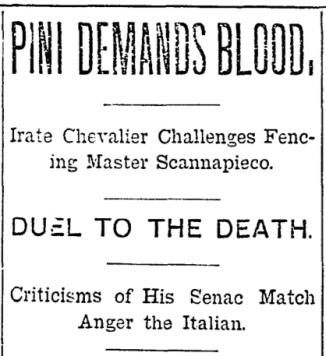
Although it is unclear if Senac was actually at fault in the incident with Pini, the fact stands that in two separate cases, fencers walked out in the middle of a public contest with Senac. Actually, a third such incident occurred in another Tammany contest with fencer Albert Vaughn, who walked off the stage after alleging that Senac “was not disposed to act in a fair and gentlemanly manner” (New York Clipper, April 12, 1884). However, in the last case, Senac had disabled Vaughn’s sword arm with a vicious cut, and it is unclear whether Vaughn took umbrage with that fact, or for other reasons. Whether the grievances of Senac’s opponents had any merit at all, or whether they were, instead, the ungracious complaints of men that could not bear defeat at the hands of a superior swordsman, is, of course, a matter of speculation.
CONCLUSION AND LEGACY
In the decades following the Monstery-Senac contest, Monstery increasingly spoke out against gamemanship in fencing, and wrote about maintaining the martial aspect of the art and science. Little more than a year before the contest, he had stated,
“An assault of arms should be conducted with the same precaution as if life itself was at stake.” (Turf, Field, and Farm, January 29, 1875)
His concern was also palpable in December of 1878, when the New York Athletic Club published its “Laws of Athletics,” which included the following provision for fencing with the foil:
“Time or stopping thrusts, delivered without the lunge, count only in favor of the giver if not hit himself; if both are hit simultaneously, the count belongs to the competitor who has hit his opponent in the higher part of the body; if hit in the same line, the point is of no count.”
Monstery published a lengthy critique of these laws in the New York Spirit of the Times, explaining,
“The rest of the rule, providing that the count in simultaneous thrusts should belong to the party striking the upper part of the body is not only unwise, but directly calculated to encourage and protect the meanest sort of trickery and cheating. It is true that, at present, our amateur fencers, as a rule, fence fairly; but if this rule be persisted in, it is only a matter of time for them to become proficient in this sort of cheating, and to ruin the art of fencing in the United States for ever. There is only one safe practice to follow in foil fencing. This is to imitate as closely as possible the contest with the naked point. No one but a maniac would take thrust for thrust from an adversary with sharp points, unless, indeed, he were a very inferior swordsman, who wished to take some sort of revenge by piercing his enemy’s shoulder, at the price of a mortal wound through his own lungs. By striking off this vicious provision, ample room will be left for the legitimate time-thrust and stopping-thrust, which are marks of the highest skill in fencing if the giver not be hit while delivering them.”
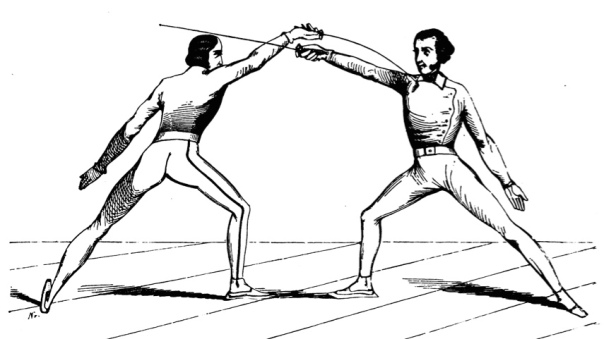
A proper time-thrust, or “coup de temps,” with opposition in sixth, shown in Gomard’s Théorie de L’Escrime, 1845.
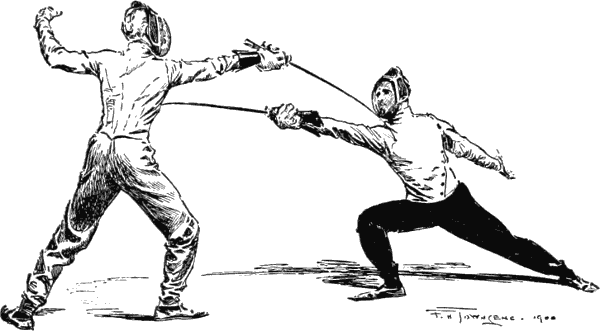
A double or simultaneous hit. In an actual combat with sharps, both fencers would be injured or possibly killed. From Baron de Bazancourt’s Secrets of the Sword, 1900.
Monstery criticized a similar rule for sabre put forth by the Club, explaining:
“The consequences of simultaneous blows with sabres cannot fail to be disastrous to both parties. In an actual sabre duel, their delivery would require two maniacs instead of one.”
In presiding over fencing contests as a judge, the available evidence suggests that Monstery was as good as his word, attempting to ensure that the sword was treated as a serious weapon. In an 1893 contest, it was noted that
“To an outsider it looked very much as if every time one man would hit the other, the struck one would cross-counter in a splendid style, returning the blow with interest. This, however, was decided by those who were up in the sport to be against the tenets of swordsmanship. ‘For,’ argued Colonel Monstery, ‘If the weapons were sharp the first blow struck would cut off the head of him who received it, and how could a man with his head cut off return a stroke?’” (Daily Inter Ocean, Nov. 3, 1893)
In his 1878 critique of the New York Athletic Club’s laws, Monstery emphasized the importance of distinguishing a “clean thrust” from a “glance,” and expressed dismay at the possibility of “a great deal of cheating” in fencing—cheating which, according to Monstery, was “sure to ensue if tournament-at-arms become popular in the United States.” He added:
“At present this cheating is confined to the lowest class of European professionals. Let us not, through ignorance, admit it into the society of American gentlemen amateurs.
Yours,
Thomas H. Monstery”
As for Senac, he was not quite done with Monstery. Although the Frenchman had been officially adjudged the winner in their 1876 contest, Senac himself seemed to acknowledge its inconclusiveness, when on January 5, 1880, in the New York Times, he challenged Monstery to yet again “fight a match with him…for the championship of America.”
This time, Monstery ignored the challenge.
Further Reading:
 Colonel Thomas H. Monstery‘s martial wisdom survives in his treatise on Boxing, Kicking, Grappling, and Fencing with the Cane and Quarterstaff, which was recently published by North Atlantic Books in book form for the first time. This volume contains a new, detailed biography of Monstery, and includes additional writings by the Colonel.
Colonel Thomas H. Monstery‘s martial wisdom survives in his treatise on Boxing, Kicking, Grappling, and Fencing with the Cane and Quarterstaff, which was recently published by North Atlantic Books in book form for the first time. This volume contains a new, detailed biography of Monstery, and includes additional writings by the Colonel.
More information about Monstery can also be gleaned from these articles:
A Grand Assault-of-Arms in Old New York, directed by Col. Monstery
Monstery and the Training of Jaguarina, America’s Champion Swordswoman
A Bare-Knuckle Fight at Colonel Monstery’s
Colonel Thomas H. Monstery and the Use of the Quarterstaff
As well as this article, written by Monstery’s great great granddaughter, Diane Hayes.
Text of this article © 2015 by Ben Miller.



